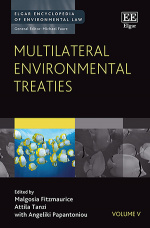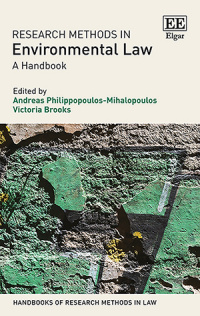
Volume 14
Hans Morten Haugen
Financialization of Mother Earth: Do Offsets and Payments or Rights-based Approaches Provide For Better Conservationist Approaches?
Five different regimes or approaches to nature conservation are analyzed: Carbon markets, Payments for Environmental Services (PES), Reduced Emissions from Deforestation and Forest Degradation (REDD), human rights and rights of nature (Mother Earth). The climate change mitigation effort is the policy context for studying these approaches. The current dominant approach involves payments and offsets, with social and environmental safeguard mechanisms being increasingly applied , influenced by substantive human rights requirements. REDD projects stand out from PES projects by being performance-based, while the Mother Earth approach has so far not had a decisive influence on policy-making. Keohane and Daniel G. Victor’s six evaluative criteria to assess regime complexes are applied to assess these regimes or approaches: (i) coherence; (ii) accountability; (iii) determinacy; (iv) sustainability; (v) epistemic embedding; and (vi) fairness. The article finds that the evaluative criteria indeed have a role to play in identifying the strengths and weaknesses of the various regimes and approaches and that the human rights regime has an under-utilised potential in guiding conservationist approaches in the context of climate change.
Menes Abinami Muzan
Institutional Mechanisms For Biosafety in Nigeria: An Appraisal of the Legal Regime Under the National Biosafety Management Agency Act, 2015
The National Biosafety Management Agency Act of 2015 has established a designated national authority to, among other things, regulate modern biotechnology activities which may cause harm to human health and Nigeria’s enormous biodiversity. Although the Biosafety Management Agency Act essentially leaves the substantive part of the biosafety framework including issues of liability and redress, to ‘futurure’ subsidiary legislation, arguably, these institutional measures demonstrate to some extent that the Nigerian government is committed to its multilateral environmental obligations for biosafety. This article generally appraises Nigeria’s biosafety regime under the 2015 National Biosafety Management Agency Act against the backdrop of and as a complement to Nigeria’s l multilateral biosafety obligations, by analyzing the extent to which the international framework is supportive of Nigeria’s domestic biosafety institutional arrangements. The article therefore, contributes to the evolving debates on the need for biosafety measure and thus argues that the ratification of the Cartagena Protocol on biosafety and the enactment of the Biosafety Management Agency Act are both positive developments which complement regulatory efforts and de facto implies that Nigeria cannot reject genetically modified organisms anymore. Hence, the country has become part of the biotechnology world and has a legally-mandated institution that regulates modern biotechnology activities for socio-economic development.
Shibani Ghosh, Sharachchandra Lele and Nakul Heble
Appellate Authorities under Pollution Control Laws in India: Powers, Problems and Potential
An aspect of environmental grievance redressal that is often over-looked in India is the effectiveness of the grievance redressal forums. Effectiveness of such forums may be evaluated on two broad dimensions: 1) ability to deliver good quality decisions and 2) accessibility. We seek to contribute to an emerging worldwide literature on environmental grievance redressal forums by examining the functioning of state-level Appellate Authorities. We analyse their effectiveness by asking some basic questions such as whether they have been set-up, who heads them, do they include experts, and how accessible are they? Our research based on RTI applications, interviews and review of government websites and documents reveals much scope for improvement. While in certain states Appellate Authorities have not been constituted, in others the composition and functioning of the Authorities do not inspire much confidence in the quality of the adjudicatory process. Finally, if popularised and strengthened, these Authorities can positively impact the access to environmental redressal in the country.
Nihaya Khalaf
Plant Breeders' Rights in Egypt: A Critical Analysis of Law 26/2015
The aim of this paper is to provide an in-depth analysis of the main features of Law 26/2015. It examines the extent to which Law 26/2015 is in line with the interest of Egypt, specifically its contribution to agricultural development in Egypt which according to its 2014 Constitution, the Egyptians’ rights to adequate food and sustainable agriculture are preserved. In doing so, this paper compares breeders’ rights under Law 26/2015 to those granted under the Law 82/2002 on the Protection of Intellectual Property Rights, in order to capture shifting objectives of the legislation in the last two decades.
Remarkable efforts have been made in Egypt to integrate plant-related concerns into legislative and policy frameworks in order to protect plant genetic resources for food and agriculture. However, the broad scope of protection provided in Law 26/2015 raises serious concerns about agriculture and food security in a country that suffers from critical food shortages. It strengthens breeders’ rights by extending their rights to harvested material, and provides for the protection of essentially derived varieties within the scope of the exclusive rights of the breeders. Law 26/2015 demonstrates how the critical aspects of introducing plant breeder rights system in a farmer dominated agricultural system were neglected.
For a developing country like Egypt, policy, practical and development implications of acceding to free trade agreements especially those including TRIPs-plus commitments should be considered. Demands for “bread freedom and social justice” of the 2011 revolution and the following uprisings have been a call for real development- one that encompasses social justice coupled with environmental sustainability and economic development.
Comments
Protecting Forest Areas under Moroccan Law from an Environmental Perspective
Nabil Madani
Moroccan forestry regulations, despite dating back to the protectorate period, have been shaped in a remarkably technical way, introducing a range of legal instruments aiming to protect forest areas. However, the legislator’s ultimate purpose submitted to colonialist power at the time, meant that purely due to economic concerns, these laws were far from tackling environmental issues. The different attempts to reform the system later on resulted in a disorderly and generally ineffective legal arsenal facing the preservation of forest resources. Furthermore, the forest must not only have an economic function, but also environmental and social functions, hence the emergence of the concept of ‘protective forests’ representing the most comprehensive instrument that exists to ensure the protection of forests.
La protection du domaine forestier en droit marocain au crible environnemental
Nabil Madani
La réglementation forestière marocaine, même s’il remonte à la période du protectorat, a été forgée d’une qualité technique remarquable introduisant un ensemble d’instruments juridiques visant la protection du domaine forestier. Nonobstant, la finalité du législateur, la force coloniale à l’époque, était loin de l’enjeu environnemental pour des soucis purement économiques. Et les différentes tentatives de réformes menées par la suite ont abouti à un arsenal juridique désordonné et généralement ineffectif face à la préservation des ressources forestières. Par ailleurs, la forêt ne doit pas avoir une seule fonction économique, mais aussi des fonctions environnementale et sociale, d’où l’émergence du concept de « forêts de protection » comme l’instrument de la protection des forêts le plus intégral qui existe.
Book reviews
Multilateral Environmental Treatises
by Malgosia Fitzmaurice, Attila Tanzi and Angeliki Papantoniou, eds. (Elgar Encyclopaedia of Environmental Law Volume V)
Reviewed by Feja Lesniewska, Research Associate, STEaPP, UCL

Research Methods in Environmental Law: A Handbook
by Andreas Philippopoulos-Mihalopoulos and Victoria Brooks, eds. (Edward Elgar 2017)
Reviewed by Zainab Lokhandwala, Birsha Ohdedar & Peter Tweedley, PhD Scholars, SOAS, University of London
